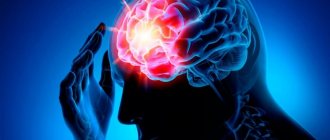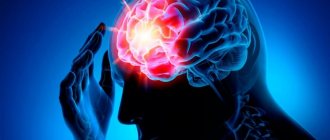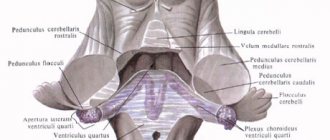And now with words.
In each test we check the dominant leg, arm, eye, side of the body. Each hemisphere controls the opposite side, therefore, if the right hand is dominant in a test, then in this test we consider the left hemisphere to be dominant, and vice versa. With the eyes, everything is more complicated, so in the seventh test, if the right eye reacted first, we note the dominance of the right hemisphere.
For the left hemisphere write the letter “L”, for the right - “P”, if in some test they are equivalent - o (zero).
- Interlocking fingers. Interlace your fingers as in the picture. Which thumb is on top? Label the opposite hemisphere as dominant.
- Rosenbach's test. Only 10% of people manage not to be stupid in this test. Take a pencil in your hand, hold it out in front of your eyes and aim at it. Close one eye, then the other. When closing which eye, the image shifts more (relative to the sight with both eyes)? Mark the opposite hemisphere as dominant in this test. If it moves the same or does not move, set it to zero.
- Napoleon pose. Cross your arms over your chest. Which hand rests on top of the other's forearm? Right - put "L", left - "P".
- Applause. Applaud with one hand on top. Which? Mark the opposite hemisphere.
- Cross your legs. Which leg is on top? The first reaction is important. Mark the opposite hemisphere.
- Wink. Which eye? If you are right, mark the right hemisphere; if you are left, mark the left.
- Get off your lazy ass and spin around on your own axis. Which way? Counterclockwise is left, clockwise is right.
- Now take an unlined piece of paper and a pen. Draw a vertical line dividing the sheet into two parts. Which part was larger? Mark the opposite hemisphere. Identical - put zero.
- Triangles and squares. Using each hand, draw three triangles and three squares on each side of the paper. Which ones are better? Mark the opposite hemisphere. Make a small allowance for untrained hands.
- Strokes. Here, too, for some reason everyone is stupid. With each hand, not counting, draw a series of vertical strokes (there is an example in the picture). Then you count the strokes. Which hand did you draw more? Mark the opposite hemisphere. If they are the same or approximately the same, mark zero.
- Using your normal hand, draw a circle and end the line with an arrow. If you drew it counterclockwise, oh, clockwise - “P”.
The mystery of the cerebral hemispheres
Mysteries of the brain: the mystery of the two hemispheres
Our time is an era of amazing discoveries: deciphering the genome, cloning, organ transplantation... But the highest mystery of nature still remains the human brain.
brain, self-knowledge
Our time is an era of amazing discoveries: genome decoding, cloning, organ transplantation. But back in the 30s of the last century, Academician I.P. Pavlov noticed: the progress of natural science for the first time noticeably stopped in front of the highest mystery of nature - the thinking brain. Cybernetics called the brain a black box. We know what information enters the brain, and we can judge how this responds to a person’s behavior, thoughts and feelings. But what's going on inside - in this box?..
The brain has two hemispheres: left and right. But they developed at different times: for millions of years people lived only with the right hemisphere, and then another one appeared, which complicated the picture. It turned out that these two hemispheres are completely autonomous. They “speak” different languages and, as a rule, do not hear each other.
University of California scientist Robert Ornstein has proven that if the “weaker” hemisphere is stimulated and involved in work together with the “stronger” (leading), the effectiveness of human activity increases by 5-10 times.
Music
The left hemisphere does not perceive music; the right hemisphere is responsible for it. On the other hand, I came across information that the corpus callosum (it connects the hemispheres) is better developed in musicians than in people not involved in music. That is, musicians' hemispheres work more harmoniously. I found the same thing when I was doing research at university. Among music school students there were significantly more people with incomplete dominance of the right hemisphere than in the control group. In the control group, students with incomplete dominance of the left hemisphere predominated.
Left hemisphere: tasks
The left hemisphere is primarily concerned with processing, analysis and deduction; convergent (“converging” - from the general to the specific) thinking; facts, figures; the end result; structure, logic and consistency; mathematical models; expediency; reducing tasks to working details; science and technology; using a sequential approach - approaching step by step; verbal (verbal), literal, concrete language; developing well-defined plans; in order.
Right hemisphere: tasks
The right hemisphere is more “interested” in abstract topics; artistic expression; constructive tasks; ideas, emotions and feelings; creative crafts; divergent (“divergent” - from the particular to the general), global thinking; a process, not a result; using experience; knowledge through images; perception; prayer, meditation, mysticism; remembering faces; spontaneity; visual; working with symbols, fantasies, dreams, metaphors and images; working with the opposite and the unknown.
The two hemispheres of the brain are connected by a small area called the corpus callosum. Through it, the hemispheres “communicate” with each other, which largely determines coordinated and consistent thinking, imagination and human behavior. If this part of the brain is damaged, a person experiences mental and behavioral disorders.
When does an accountant need the right hemisphere?
In an emergency situation
Left-brained people delve into details, are scrupulous about details, and like to solve problems sequentially. But when you need to complete 10 of your own tasks in a day and also close the tasks of a sick colleague, the usual plan may not work.
Here it is important to assess what is truly urgent and fraught with serious problems for the company, and for what matters a delay, although undesirable, is not fatal. Somewhere, ask your colleagues for help, somewhere, ask programmers to write a simple script that will save you from mechanical Ctrl-C, Ctrl-V, somewhere, have a human conversation with your manager.
There are a lot of options, but to see them, you need to get out of the linear sequence of tasks and look at the situation from a bird's eye view. If you succeed, your right hemisphere is also awake.
When you communicate with people
It would seem that all of them are adults, but from year to year employees do not report on business trips, and contractors do not send signed documents. That’s just how people are: regulations and rules motivate few people. You need to include the negotiator, hear the emotions of the interlocutor, say why you need this or that document by a certain deadline (yes, again).
It is easier for right-brain people to take the position of another person and go beyond rational argumentation. But everyone can learn this.
Read about how to write to colleagues and partners so that issues are resolved and no one leaves offended, in our instructional article from editor Lyudmila Sarycheva.
If you are launching a large project
Let’s say you decide to be the driver of EDI implementation in a company. We agreed on the budget, provided for all the steps, appointed those responsible, and estimated the payback period for the project. But the integration has been delayed, colleagues are stalling the process, and counterparties are in no hurry to abandon the paper. No matter how detailed a roadmap you develop, something will still go wrong.
This is normal: life is richer than our assumptions. But such projects are easier for people who react flexibly to changes, keep several scenarios for the development of events in mind at once and can act in situations of uncertainty. And such skills are ensured by the coordinated work of the right and left hemispheres.
When you're not at work (well, suddenly)
The right hemisphere helps us humans navigate in space - find our way in the forest or in an unfamiliar city.
It is the right hemisphere that helps us solve creative problems more easily. Come up with a quest for the birthday of your 10-year-old son and a crowd of his friends? Shoot a video for your mother's anniversary? Want to come up with an unusual gift for your husband who has everything? It is the right hemisphere that helps us “go beyond limits” and show our creativity.
The right hemisphere is also responsible for intuition, teaching us to “read between the lines.” With a poorly developed right hemisphere, a person can take metaphors and jokes literally. By using the right hemisphere of the brain, we develop emotional intelligence: we easily express our emotions and understand the emotions of others, notice the intonation in the interlocutor’s voice, recognize gestures and facial expressions, and learn to sympathize.
Harmony between the hemispheres of our brain makes our life more fulfilling, giving free rein to both our mind and feelings. By using both hemispheres, we better concentrate on the task and can choose the most optimal way to solve it - taking into account all the variables. And by acting flexibly, we maintain clarity of mind for many years.
If the right hemisphere is dominant
Someone who solves problems using the right hemisphere:
- softens rational thought with emotional and intuitive preferences;
- uses various methods of “bringing” extraconscious material into understanding;
- avoids censorship of ideas during their “maturation”;
- considers divergent, even contradictory, ideas with respect rather than with skepticism and defensiveness;
- tries not to neglect intuition;
- tests any rational way of solving a problem to see if it feels intuitively good during the development process and in the final solution;
- tries to remain constantly aware of himself.
Perception of reality
The right hemisphere perceives information as a whole, ensures the perception of reality in all its diversity and complexity, in general with all its constituent elements. It works through many channels at once and is capable of reconstructing the whole from its parts, in particular, it is responsible for the perception of location and spatial orientation.
What is the left hemisphere of the brain responsible for?
More details
Understand each other
The result is that the two hemispheres live in different realities and express themselves in completely different ways. For example, the lecturer builds certain logical connections and strings together concepts. But not everyone in the audience understands him, and then he names a certain metaphor and sees that some of the listeners grab a pen to write down an image they understand.
Some people find it difficult to think, reason, and comprehend logical connections. They talk about their problems and, when you manage to understand the reason for their condition, they are sincerely surprised: “Why has this never occurred to me?” Other people are bad with emotions. They do not understand why feelings are needed, and often even despise mental anguish.
In one of the sciences that understand the mystery of the brain - neuropsychology - it is customary to talk about the dominance of one of the cerebral hemispheres and the so-called interhemispheric asymmetry. This asymmetry is normal. It is believed that in men the left hemisphere of the brain is predominant - dominant, and in women - the right hemisphere of the brain.
Which hemisphere is dominant in you: test
To determine your dominant hemisphere, answer 11 questions. You can draw a sign with two columns and 12 lines on a piece of paper or print our template.
Which hemisphere is your dominant?
| Job No. | What to do | Left hemisphere (LM) | Right hemisphere (RH) |
| 1 | Interlace your fingers into a lock. Which thumb is on top? Mark the opposite hemisphere | ||
| 2 | Rosenbach's test. Extend your hand with a pencil or pen in front of your nose. Aim at him with your eyes. Alternately squint one eye or the other. When you close which eye, the image shifts more? Mark the opposite hemisphere | ||
| 3 | Cross your arms over your chest in Napoleon pose. Which hand was on top of the other's forearm? Mark the opposite hemisphere | ||
| 4 | Applaud with one hand on top. Which hand was on top? Mark the opposite hemisphere | ||
| 5 | Cross your legs. Which leg was on top? Mark the opposite hemisphere | ||
| 6 | Rotation. Stand up. Rotate around your axis. If you rotated counterclockwise, mark the left hemisphere; if clockwise, mark the right hemisphere | ||
| 7 | Wink. Which eye did you wink with? Mark this hemisphere | ||
| 8 | Vertical bar. Draw a vertical line on the sheet dividing the sheet into two parts. Which part was larger? Mark the opposite hemisphere. If they are the same, put zero | ||
| 9 | Triangles and squares. Using each hand, draw three triangles and three squares on each side of the paper. Which ones are better? Mark the opposite hemisphere | ||
| 10 | Strokes. With each hand, not counting, draw a series of vertical strokes. Then count the strokes. Which hand did you draw more? Mark the opposite hemisphere. If the same, put zero | ||
| 11 | Circle. Using your normal hand, draw a circle and end the line with an arrow. If drawn counterclockwise, mark the left hemisphere; if drawn clockwise, mark the right hemisphere. | ||
| TOTAL | |||
Download the table in docx or pdf format.
We calculate the result using the formula (LP - answers for the left hemisphere, PP - answers for the right hemisphere):
Key to the test:
- more than 30% - your left hemisphere dominates;
- from 10 to 30% - the left hemisphere is partially dominant;
- from -10% to +10% – the right hemisphere is partially dominant;
- less than -10% - the right hemisphere dominates.
Perfect balance?
So what then can be considered a psychological norm? Someone may answer right away: equilibrium, balanced development of both hemispheres. But how can this be achieved and what will human culture look like in this case? It's hard to imagine. Perhaps it will not contain outstanding discoveries and creations, but will something qualitatively new arise? This encourages us to continue to think about the mysteries of the brain.
Author: Pavel Gurevich, Doctor of Philological and Philosophical Sciences, Professor
The material used photographs belonging to shutterstock.com









